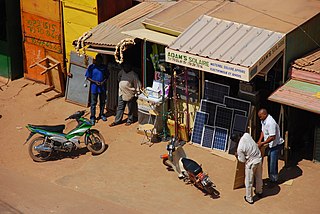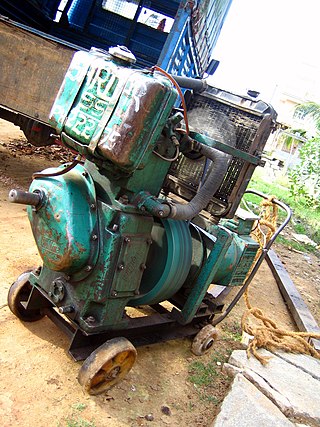
In developing countries and some areas of more developed countries, energy poverty is lack of access to modern energy services in the home. In 2022, 759 million people lacked access to consistent electricity and 2.6 billion people used dangerous and inefficient cooking systems. Their well-being is negatively affected by very low consumption of energy, use of dirty or polluting fuels, and excessive time spent collecting fuel to meet basic needs.
For solar power, South Asia has the ideal combination of both high solar insolation and a high density of potential customers.

The developing nations of Africa are popular locations for the application of renewable energy technology. Currently, many nations already have small-scale solar, wind, and geothermal devices in operation providing energy to urban and rural populations. These types of energy production are especially useful in remote locations because of the excessive cost of transporting electricity from large-scale power plants. The applications of renewable energy technology has the potential to alleviate many of the problems that face Africans every day, especially if done in a sustainable manner that prioritizes human rights.
Brazil has the largest electricity sector in Latin America. Its capacity at the end of 2021 was 181,532 MW. The installed capacity grew from 11,000 MW in 1970 with an average yearly growth of 5.8% per year. Brazil has the largest capacity for water storage in the world, being dependent on hydroelectricity generation capacity, which meets over 60% of its electricity demand. The national grid runs at 60 Hz and is powered 83% from renewable sources. This dependence on hydropower makes Brazil vulnerable to power supply shortages in drought years, as was demonstrated by the 2001–2002 energy crisis.

Renewable energy in developing countries is an increasingly used alternative to fossil fuel energy, as these countries scale up their energy supplies and address energy poverty. Renewable energy technology was once seen as unaffordable for developing countries. However, since 2015, investment in non-hydro renewable energy has been higher in developing countries than in developed countries, and comprised 54% of global renewable energy investment in 2019. The International Energy Agency forecasts that renewable energy will provide the majority of energy supply growth through 2030 in Africa and Central and South America, and 42% of supply growth in China.
Morocco's energy policy is set independently by two agencies of the government: the Office of Hydrocarbons and Mining (ONHYM) which sets domestic oil policy, and the Office National de l'Electricité (ONE), which sets policy with regard to electricity. The two major weaknesses of the energy policy of Morocco are the lack of coordination between these two agencies and the lack of development of domestic energy sources.
Benin is a coastal country located in the Gulf of Guinea in Western Africa, which is a resource rich region. Energy in Benin has a diverse energy mix and takes several forms including: solar, wind, hydropower, biomass, fossil resources, and mineral resources. Out of this energy mix, about 60% of energy comes from biomass. Benin is also dependent on energy imports from Ghana and Côte d'Ivoire. While power plants and other energy facilities were built in the 1950s and 1960s, the lack of investment has led to deterioration over time. Similarly, its location in the Gulf of Guinea has led to an attempt of oil production starting in the late 1980s. However, due to unprofitable operations, oil production halted in 1998.

Husk Power Systems, founded in 2008, is a company based in Fort Collins, Colorado, US, that provides clean energy services to off-grid or weak grid rural communities in East Africa, West Africa and South Asia, primarily by building renewable energy mini-grids/micro-grids. Its original technology generated electricity using a biomass gasifier that created fuel from rice husks, a waste product of rice hullers that separate the husks as chaff from the rice, a staple food in both Asia and Africa. In the mid-2010s, with the rapid decline in the price of solar PV and batteries, Husk pivoted its business model to focus more on solar-plus-storage mini-grids, while continuing to use biomass in combination with solar to serve communities with larger electricity demand. In 2021, Husk Power was recognized in the REN21 Renewables Global Status Report as the first mini-grid company to achieve significant scale, by surpassing 100 solar hybrid community mini-grids, and 5,000 small business customers. In 2022, Husk signed an Energy Compact with the United Nations, in which it set a target of building 5,000 mini-grids and connecting at least 1 million customers by 2030.

In 2018, Nigeria's primary energy consumption was about 155 Mtoe. Most of the energy comes from traditional biomass and waste, which accounted for 73.5% of total primary consumption in 2018. The rest is from fossil fuels (26.4%) and hydropower.

An energy transition is a major structural change to energy supply and consumption in an energy system. Currently, a transition to sustainable energy is underway to limit climate change. As much sustainable energy is renewable it is also known as the renewable energy transition. The current transition aims to reduce greenhouse gas emissions from energy quickly and sustainably, mostly by phasing-down fossil fuels and changing as many processes as possible to operate on low carbon electricity. A previous energy transition perhaps took place during the Industrial Revolution from 1760 onwards, from wood and other biomass to coal, followed by oil and later natural gas.

Most of Kenya's electricity is generated by renewable energy sources. Access to reliable, affordable, and sustainable energy is one of the 17 main goals of the United Nations’ Sustainable Development Goals. Development of the energy sector is also critical to help Kenya achieve the goals in Kenya Vision 2030 to become a newly industrializing, middle-income country. With an installed power capacity of 2,819 MW, Kenya currently generates 826 MW hydroelectric power, 828 geothermal power, 749 MW thermal power, 331 MW wind power, and the rest from solar and biomass sources. Kenya is the largest geothermal energy producer in Africa and also has the largest wind farm on the continent. In March 2011, Kenya opened Africa's first carbon exchange to promote investments in renewable energy projects. Kenya has also been selected as a pilot country under the Scaling-Up Renewable Energy Programmes in Low Income Countries Programme to increase deployment of renewable energy solutions in low-income countries. Despite significant strides in renewable energy development, about a quarter of the Kenyan population still lacks access to electricity, necessitating policy changes to diversify the energy generation mix and promote public-private partnerships for financing renewable energy projects.

Ethiopia generates most of its electricity from renewable energy, mainly hydropower.

The Nigerian energy supply crisis refers to the ongoing failure of the Nigerian power sector to provide adequate electricity supply to domestic households and industrial producers despite a rapidly growing economy, some of the world's largest deposits of coal, oil, and gas and the country's status as Africa's largest oil producer. Currently, only 45% of Nigeria's population is connected to the energy grid whilst power supply difficulties are experienced around 85% of the time and almost nonexistent in certain regions. At best, average daily power supply is estimated at four hours, although several days can go by without any power at all. Neither power cuts nor restorations are announced, leading to calls for a load shedding schedule during the COVID-19 lockdowns to aid fair distribution and predictability.
Tanzania has a wide range of energy resources in abundance, which are not yet fully exploited. These include; wood fuel, other biomass fuels, hydropower, natural gas, coal, wind, geothermal, uranium and solar.

Nepal is a country enclosed by land, situated between China and India. It has a total area of 147,181 square kilometers and a population of 29.16 million. It has a small economy, with a GDP of $33.66 billion in 2020, amounting to about 1% of South Asia and 0.04% of the World's GDP.
In 2013, renewable energy provided 26.44% of the total electricity in the Philippines and 19,903 gigawatt-hours (GWh) of electrical energy out of a total demand of 75,266 gigawatt-hours. The Philippines is a net importer of fossil fuels. For the sake of energy security, there is momentum to develop renewable energy sources. The types available include hydropower, geothermal power, wind power, solar power and biomass power. The government of the Philippines has legislated a number of policies in order to increase the use of renewable energy by the country.

Renewable energy in South Africa is energy generated in South Africa from renewable resources, those that naturally replenish themselves—such as sunlight, wind, tides, waves, rain, biomass, and geothermal heat. Renewable energy focuses on four core areas: electricity generation, air and water heating/cooling, transportation, and rural energy services. The energy sector in South Africa is an important component of global energy regimes due to the country's innovation and advances in renewable energy. South Africa's greenhouse gas (GHG) emissions is ranked as moderate and its per capita emission rate is higher than the global average. Energy demand within the country is expected to rise steadily and double by 2025.
Burning of charcoal and wood fuel provides approximately 94 percent of the energy in Malawi. Much of the renewable hydroelectric potential of the country is untapped. As per 2018 Population and Housing Census, the national electrification rate in Malawi was 10%, with 37% of the urban population and only 2% of the rural population having access to electricity.
A mini-grid is an aggregation of electrical loads and one or more energy sources operating as a single system providing electricity and possibly heat, isolated from a main power grid. A modern mini-grid may include renewable- and fossil fuel-based power generation, energy storage, and load control. A mini grid can be fully isolated from the main grid or interconnected to it. If it is interconnected to the main grid, it must also be able to isolate (“island”) from the main grid and continue to serve its customers while operating in an island or autonomous mode. Mini-grids are used as a cost-effective solution for electrifying rural communities where a grid connection is challenging in terms of transmission and cost for the end user population density, with mini-grids often used to electrify rural communities of a hundred or more households that are 10 km or more from the main grid.
Ifeanyi Orajaka is a Nigerian engineer and entrepreneur. He is the co-founder and chief executive officer of Green Village Electricity (GVE) Projects Limited, a renewable energy business in Sub-Saharan Africa.

















